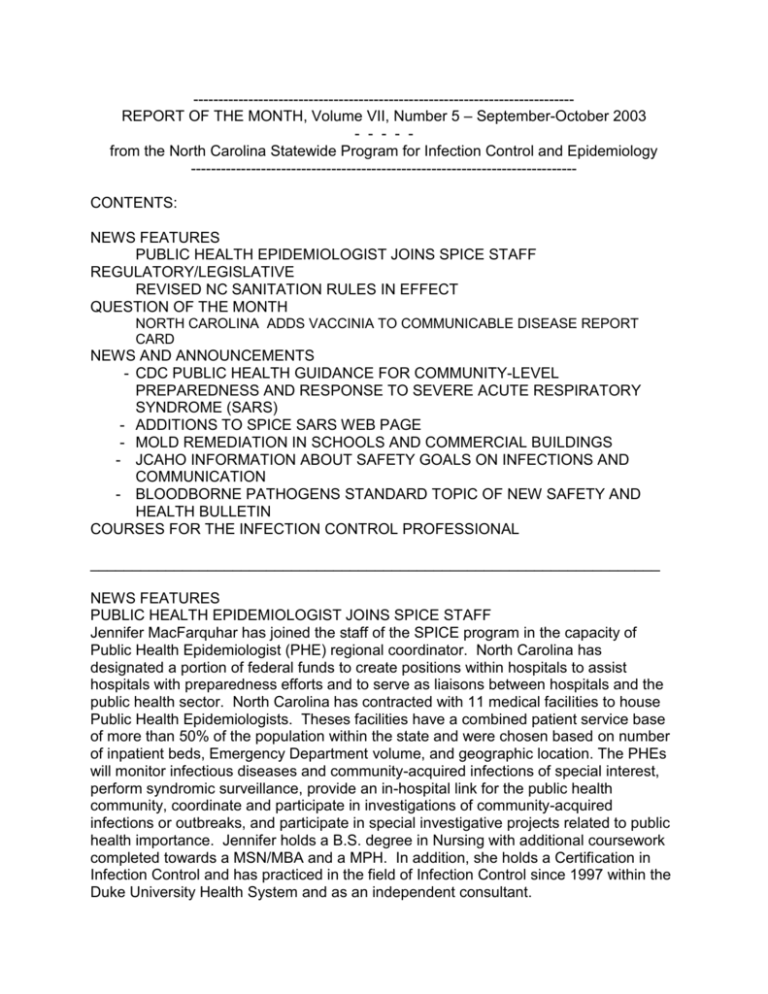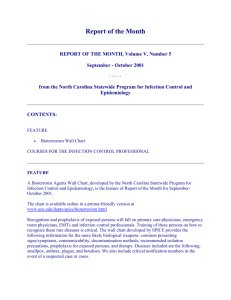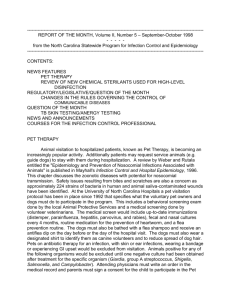Vol VII No 5
advertisement

---------------------------------------------------------------------------REPORT OF THE MONTH, Volume VII, Number 5 – September-October 2003 - - - - from the North Carolina Statewide Program for Infection Control and Epidemiology ----------------------------------------------------------------------------CONTENTS: NEWS FEATURES PUBLIC HEALTH EPIDEMIOLOGIST JOINS SPICE STAFF REGULATORY/LEGISLATIVE REVISED NC SANITATION RULES IN EFFECT QUESTION OF THE MONTH NORTH CAROLINA ADDS VACCINIA TO COMMUNICABLE DISEASE REPORT CARD NEWS AND ANNOUNCEMENTS - CDC PUBLIC HEALTH GUIDANCE FOR COMMUNITY-LEVEL PREPAREDNESS AND RESPONSE TO SEVERE ACUTE RESPIRATORY SYNDROME (SARS) - ADDITIONS TO SPICE SARS WEB PAGE - MOLD REMEDIATION IN SCHOOLS AND COMMERCIAL BUILDINGS - JCAHO INFORMATION ABOUT SAFETY GOALS ON INFECTIONS AND COMMUNICATION - BLOODBORNE PATHOGENS STANDARD TOPIC OF NEW SAFETY AND HEALTH BULLETIN COURSES FOR THE INFECTION CONTROL PROFESSIONAL ____________________________________________________________________ NEWS FEATURES PUBLIC HEALTH EPIDEMIOLOGIST JOINS SPICE STAFF Jennifer MacFarquhar has joined the staff of the SPICE program in the capacity of Public Health Epidemiologist (PHE) regional coordinator. North Carolina has designated a portion of federal funds to create positions within hospitals to assist hospitals with preparedness efforts and to serve as liaisons between hospitals and the public health sector. North Carolina has contracted with 11 medical facilities to house Public Health Epidemiologists. Theses facilities have a combined patient service base of more than 50% of the population within the state and were chosen based on number of inpatient beds, Emergency Department volume, and geographic location. The PHEs will monitor infectious diseases and community-acquired infections of special interest, perform syndromic surveillance, provide an in-hospital link for the public health community, coordinate and participate in investigations of community-acquired infections or outbreaks, and participate in special investigative projects related to public health importance. Jennifer holds a B.S. degree in Nursing with additional coursework completed towards a MSN/MBA and a MPH. In addition, she holds a Certification in Infection Control and has practiced in the field of Infection Control since 1997 within the Duke University Health System and as an independent consultant. REGULATORY/LEGISLATIVE REVISED NC SANITATION RULES IN EFFECT The North Carolina Department of Environment and Natural Resources completed the revision to Rules Governing the Sanitation of Hospitals, Nursing Homes, Adult Care Homes and Other Institutions (15A NCAC 18A.1300). The revised rules became effective June 1, 2003. The rule revisions were made with the assistance of representatives from industry (long term care and acute care hospitals), Division of Facility Services, and the Division of Environmental Health. Some of the significant rule changes or additions are listed below. Where bedpans are cleaned in patient rooms, minimum bedpan cleaning facilities shall consist of a toilet room with bedpan lugs or spray arms. Where facilities for cleaning bedpans are not provided in patient rooms, bedpans shall be taken to a soiled utility room to be cleaned and disinfected using an EPA registered hospital disinfectant after each use. Hand sinks shall not be used (as a source of water) for cleaning (rinsing) bedpans or bedside commodes. Where disposable bedpans are reused, they shall be labeled with the patient’s name and date and shall not be used by more than one patient. Disposable water pitches no longer have an arbitrary time for replacement. The rule states to mark pitchers with the patient’s name, and they shall be used only by that patient and shall be disposed of or replaced when visibly soiled. Feeding syringes which are reused shall be labeled with the patient’s name and date when opened, shall be disassembled and rinsed after each use, and shall be disposed of in 24 hours. Oral suction (Yonkers) catheters which are reused shall be flushed after each use and shall be disposed of within 24 hours. Feeding syringes and oral suction catheters shall be stored in clean containers. Pet therapy and food protection rules are now defined. No live animals shall be allowed in any room where food is prepared or stored. Live animals shall be allowed in dining areas if their presence will not result in contamination of food, clean equipment, or serving utensils such as in the following situations: fish or animals in display tanks or support animals. Carpeting has now been approved for use in healthcare institutions. Carpeting shall be maintained clean, odor free, dry and in good repair. A complete copy of the NC Sanitation Rules is online at http://www.deh.enr.state.nc.us/ehs/rules/t15a-18a.13.pdf QUESTION OF THE MONTH NORTH CAROLINA ADDS VACCINIA TO COMMUNICABLE DISEASE REPORT CARD Q: I saw a sample of the new white NC Communicable Disease Report Card with vaccinia listed as one of the diseases. Does this mean we need to report every person who responds to the smallpox vaccination and has a vaccinia pustule? A.: No, for communicable disease reporting purposes, the reporting of vaccinia applies only to inadvertent inoculation of vaccinia by a vaccinee with an infectious pustule coming in contact with another person. In that situation, the other person would be the one with a reportable disease. Per Dr. Megan Davies, NC Communicable Disease Section Note: Monkeypox and SARS were also added to the list of diseases that must be reported within 24 hours. The new white cards are available for use. NEWS AND ANNOUNCEMENTS CDC PUBLIC HEALTH GUIDANCE FOR COMMUNITY-LEVEL PREPAREDNESS AND RESPONSE TO SEVERE ACUTE RESPIRATORY SYNDROME (SARS) October 17, 2003. The Centers for Disease Control and Prevention (CDC) posted this document in draft form to assist local and state public health and healthcare officials in their preparations for a possible reemergence of SARS during the approaching respiratory disease season. CDC invites interested public health partners to submit comments on the draft document to: sars-plan@cdc.gov. For more information about the SARS Plan, visit CDC's web site at http://www.cdc.gov/ncidod/sars/ or contact the Office of Communication at 404-639-3286. ADDITIONS TO SPICE SARS WEB PAGE For information on SARS, see the Statewide Program for Infection Control and Epidemiology (SPICE) web page on SARS. A recent addition is the “UNC Health Care Practice Improvements for Management of SARS,” September 30, 2003. http://www.unc.edu/depts/spice/SARS.html MOLD REMEDIATION IN SCHOOLS AND COMMERCIAL BUILDINGS This document presents guidelines for the remediation/cleanup of mold and moisture problems in schools and commercial buildings; these guidelines include measures designed to protect the health of building occupants and remediators. It is available online at http://www.epa.gov/iaq/molds/images/moldremediation.pdf JCAHO INFORMATION ABOUT SAFETY GOALS ON INFECTIONS AND COMMUNICATION Joint Commission on Accreditation of Healthcare Organizations (JCAHO) has posted a new frequently asked questions (FAQ) document that clarifies the safety goal on infections and adherence to CDC hand hygiene guidelines. These FAQs also add information on the safety goal, including the new requirements for a JCAHO-approved minimum list of "do not use" abbreviations, acronyms and symbols; plus at least three organization-selected "do not use" abbreviations, acronyms or symbols. http://www.jcaho.org/accredited+organizations/patient+safety/04+npsg/04_faqs.htm printer-friendly version: http://www.jcaho.org/accredited+organizations/patient+safety/04+npsg/2004+national+p atient+safety+goals.pdf BLOODBORNE PATHOGENS STANDARD TOPIC OF NEW SAFETY AND HEALTH BULLETIN OSHA recently published a bulletin reiterating the agency's policy on disposal of contaminated needles and blood tube holders following blood drawing procedures. OSHA's bloodborne pathogens standard prohibits the removal of needles from medical devices and removal of contaminated needles from blood tube holders following a blood drawing procedure. The safety and health information bulletin details those requirements and also includes an Evaluation Toolbox that supplies guidance on the evaluation, selection, and appropriate use of engineering controls. The bulletin also provides the most recent sharps injury data from the Exposure Prevention Information Network. http://www.osha.gov/dts/shib/shib101503.html COURSES FOR THE INFECTION CONTROL PROFESSIONAL "Infection Control in Long-Term Care Facilities” will be held in Chapel Hill March 22-24, 2004. “Infection Control Part I: Clinical Surveillance of Healthcare-Associated Infections” will be held in Chapel Hill May 3-7, 2004. “Infection Control Part II: The ICP as an Environmentalist” will be held in Chapel Hill in the fall of 2004 -----------------------------------------------------------------------------------Contributors to Report of the Month: Karen K. Hoffmann, RN, MS, CIC; William A. Rutala, PhD, MPH; David J. Weber, MD, MPH; Jennifer MacFarquhar, RN, BSN, CIC; Eva P. Clontz, MEd. -----------------------------------------------------------------------------------To subscribe to the Report of the Month, send email to spice@unc.edu Report of the Month is also available on the home page of the Statewide Program for Infection Control and Epidemiology at http://www.unc.edu/depts/spice/ The Statewide Program for Infection Control and Epidemiology (SPICE) is funded by the General Assembly of North Carolina to serve the State. SPICE is not a regulatory agency but provides education and consultation to North Carolina healthcare facilities. Copyright 2003 Statewide Program for Infection Control and Epidemiology






